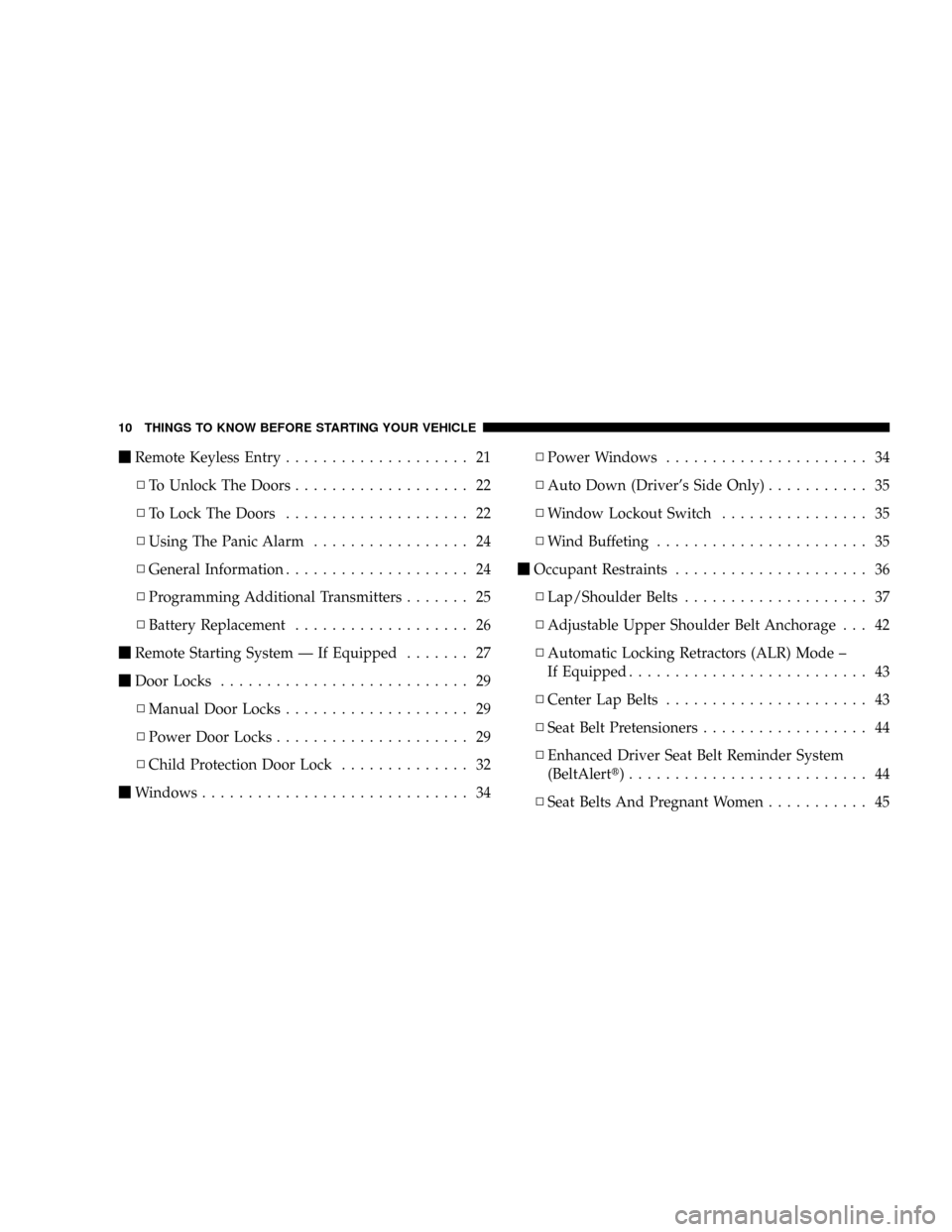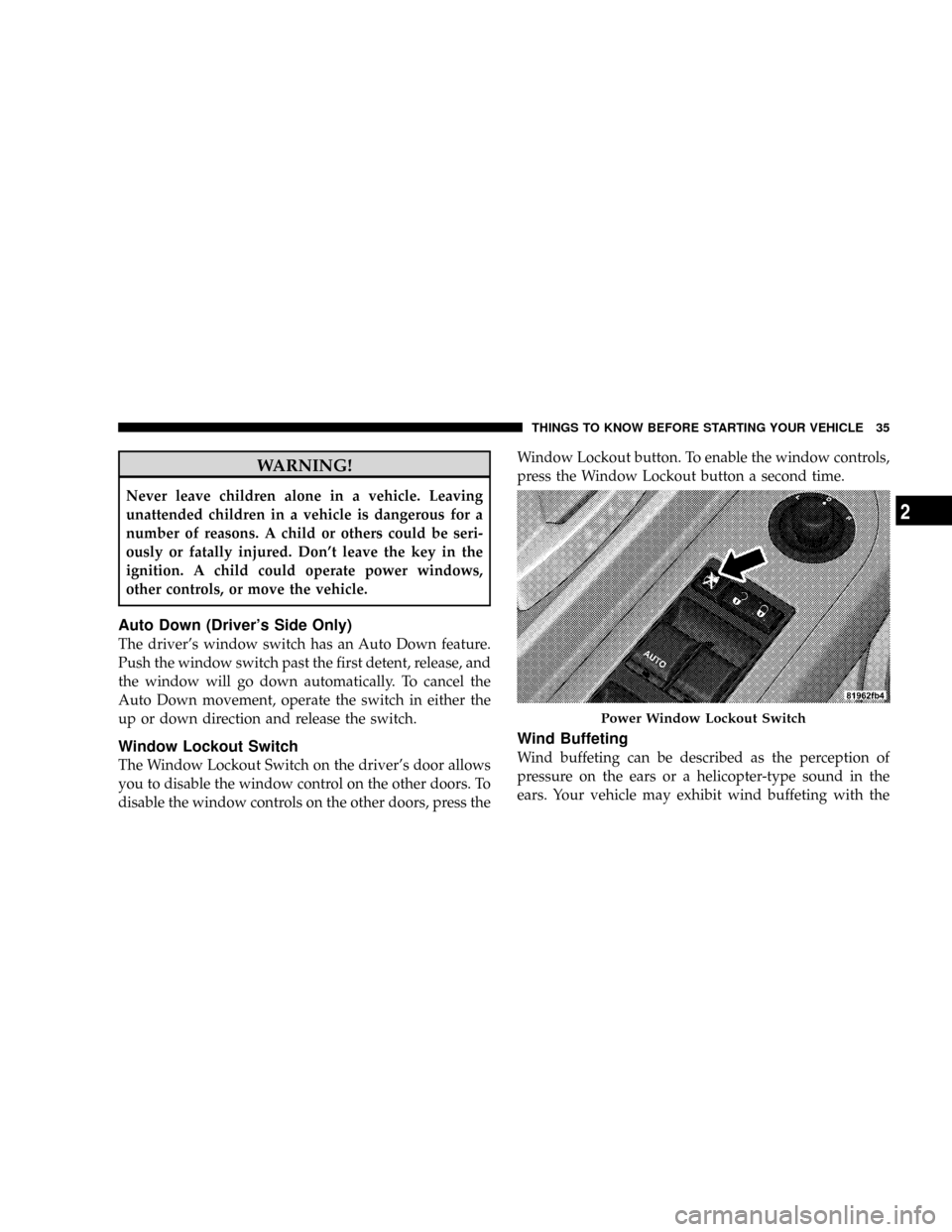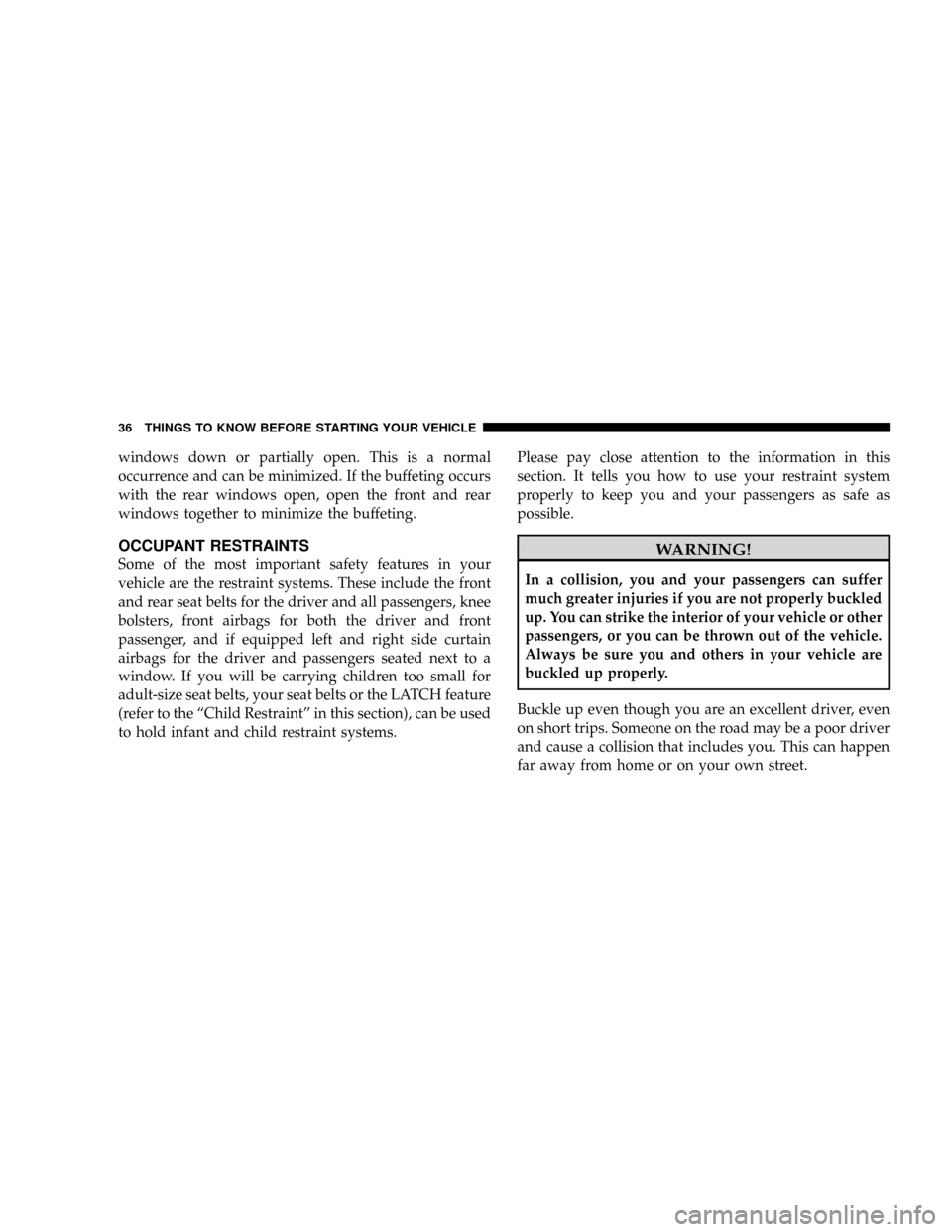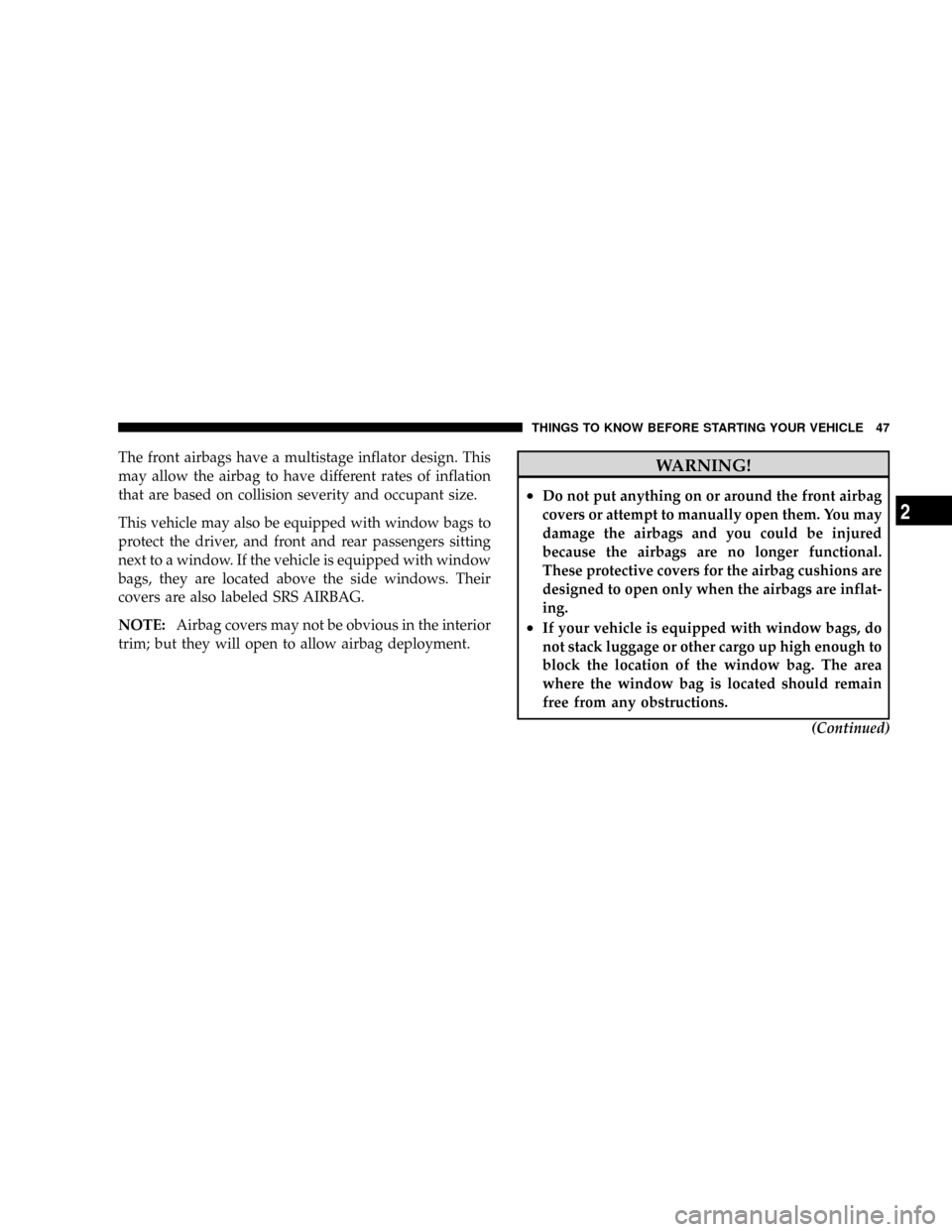Page 8 of 449
WARNINGS AND CAUTIONS
This Owner's Manual containsWARNINGSagainst op-
erating procedures that could result in an accident or
bodily injury. It also containsCAUTIONSagainst proce-
dures that could result in damage to your vehicle. If you
do not read this entire manual, you may miss important
information. Observe all Warnings and Cautions.
VEHICLE IDENTIFICATION NUMBER
The Vehicle Identification Number (VIN) is located on
the left front corner of the instrument panel pad, visible
from outside of the vehicle through the windshield. This
number also appears on the Automobile Information
Disclosure Label affixed to a window on your vehicle.
Save this label for a convenient record of your vehicle
identification number and optional equipment.NOTE:It is illegal to remove the VIN.
VIN Location
6 INTRODUCTION
Page 12 of 449

mRemote Keyless Entry.................... 21
NTo Unlock The Doors................... 22
NTo Lock The Doors.................... 22
NUsing The Panic Alarm................. 24
NGeneral Information.................... 24
NProgramming Additional Transmitters....... 25
NBattery Replacement................... 26
mRemote Starting System Ð If Equipped....... 27
mDoor Locks........................... 29
NManual Door Locks.................... 29
NPower Door Locks..................... 29
NChild Protection Door Lock.............. 32
mWindows............................. 34NPower Windows...................... 34
NAuto Down (Driver's Side Only)........... 35
NWindow Lockout Switch................ 35
NWind Buffeting....................... 35
mOccupant Restraints..................... 36
NLap/Shoulder Belts.................... 37
NAdjustable Upper Shoulder Belt Anchorage . . . 42
NAutomatic Locking Retractors (ALR) Mode ±
If Equipped.......................... 43
NCenter Lap Belts...................... 43
NSeat Belt Pretensioners.................. 44
NEnhanced Driver Seat Belt Reminder System
(BeltAlertt).......................... 44
NSeat Belts And Pregnant Women........... 45
10 THINGS TO KNOW BEFORE STARTING YOUR VEHICLE
Page 15 of 449
NOTE:If you try to remove the key before you place the
shift lever in PARK, the key may become temporarily
trapped in the ignition cylinder. If this occurs, rotate thekey to the right slightly, then remove the key as de-
scribed. If a malfunction occurs, the system will trap the
key in the ignition cylinder to warn you that this safety
feature is inoperable. The engine can be started and
stopped, but the key cannot be removed until you obtain
service.
WARNING!
Never leave children alone in a vehicle. Leaving
unattended children in a vehicle is dangerous for a
number of reasons. A child or others could be seri-
ously or fatally injured. Don't leave the key in the
ignition. A child could operate power windows,
other controls, or move the vehicle.
Ignition Switch Positions
1 Ð ACC 4 Ð ON/RUN
2 Ð LOCK 5 Ð START
3 Ð OFFTHINGS TO KNOW BEFORE STARTING YOUR VEHICLE 13
2
Page 35 of 449
To use the system, open each rear door, slide the lever up
to engage the locks, and down to disengage the child-
protection locks. When the system on a door is engaged,
that door can only be opened by using the outside door
handle, even if the inside door lock is in the unlocked
position.
WARNING!
Avoid trapping anyone in a vehicle in a collision.
Remember that the rear doors can only be opened
from the outside when the child protection locks are
engaged.NOTE:
²After setting the child protection door lock system,
always test the door from the inside to make certain it
is in the desired position.
²For emergency exit with the system engaged, move
the door lock switch to the UNLOCK position, roll
down the window and open the door with the outside
door handle.
THINGS TO KNOW BEFORE STARTING YOUR VEHICLE 33
2
Page 36 of 449
WINDOWS
Power Windows
The control on the left front door has up-down switches
that give you finger-tip control of all four power win-
dows. There is a single opening and closing switch on the
passenger doors for passenger window control. The
windows will operate when the ignition switch is turned
to the ON or ACC position, and for ten minutes after the
ignition is turned OFF or the driver's door is opened.
Power Window Switch
34 THINGS TO KNOW BEFORE STARTING YOUR VEHICLE
Page 37 of 449

WARNING!
Never leave children alone in a vehicle. Leaving
unattended children in a vehicle is dangerous for a
number of reasons. A child or others could be seri-
ously or fatally injured. Don't leave the key in the
ignition. A child could operate power windows,
other controls, or move the vehicle.
Auto Down (Driver's Side Only)
The driver's window switch has an Auto Down feature.
Push the window switch past the first detent, release, and
the window will go down automatically. To cancel the
Auto Down movement, operate the switch in either the
up or down direction and release the switch.
Window Lockout Switch
The Window Lockout Switch on the driver's door allows
you to disable the window control on the other doors. To
disable the window controls on the other doors, press theWindow Lockout button. To enable the window controls,
press the Window Lockout button a second time.
Wind Buffeting
Wind buffeting can be described as the perception of
pressure on the ears or a helicopter-type sound in the
ears. Your vehicle may exhibit wind buffeting with the
Power Window Lockout Switch
THINGS TO KNOW BEFORE STARTING YOUR VEHICLE 35
2
Page 38 of 449

windows down or partially open. This is a normal
occurrence and can be minimized. If the buffeting occurs
with the rear windows open, open the front and rear
windows together to minimize the buffeting.
OCCUPANT RESTRAINTS
Some of the most important safety features in your
vehicle are the restraint systems. These include the front
and rear seat belts for the driver and all passengers, knee
bolsters, front airbags for both the driver and front
passenger, and if equipped left and right side curtain
airbags for the driver and passengers seated next to a
window. If you will be carrying children too small for
adult-size seat belts, your seat belts or the LATCH feature
(refer to the ªChild Restraintº in this section), can be used
to hold infant and child restraint systems.Please pay close attention to the information in this
section. It tells you how to use your restraint system
properly to keep you and your passengers as safe as
possible.WARNING!
In a collision, you and your passengers can suffer
much greater injuries if you are not properly buckled
up. You can strike the interior of your vehicle or other
passengers, or you can be thrown out of the vehicle.
Always be sure you and others in your vehicle are
buckled up properly.
Buckle up even though you are an excellent driver, even
on short trips. Someone on the road may be a poor driver
and cause a collision that includes you. This can happen
far away from home or on your own street.
36 THINGS TO KNOW BEFORE STARTING YOUR VEHICLE
Page 49 of 449

The front airbags have a multistage inflator design. This
may allow the airbag to have different rates of inflation
that are based on collision severity and occupant size.
This vehicle may also be equipped with window bags to
protect the driver, and front and rear passengers sitting
next to a window. If the vehicle is equipped with window
bags, they are located above the side windows. Their
covers are also labeled SRS AIRBAG.
NOTE:Airbag covers may not be obvious in the interior
trim; but they will open to allow airbag deployment.WARNING!
²Do not put anything on or around the front airbag
covers or attempt to manually open them. You may
damage the airbags and you could be injured
because the airbags are no longer functional.
These protective covers for the airbag cushions are
designed to open only when the airbags are inflat-
ing.
²If your vehicle is equipped with window bags, do
not stack luggage or other cargo up high enough to
block the location of the window bag. The area
where the window bag is located should remain
free from any obstructions.
(Continued)
THINGS TO KNOW BEFORE STARTING YOUR VEHICLE 47
2